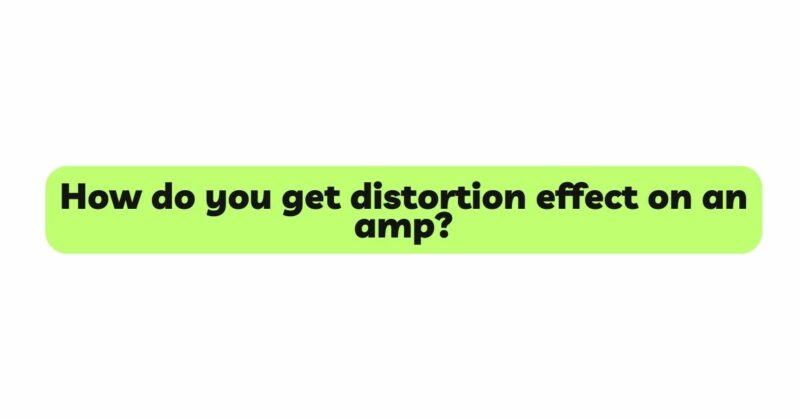Distortion is the lifeblood of many electric guitar-driven genres, injecting energy, intensity, and a captivating edge into your sound. Achieving the coveted distortion effect on your guitar amplifier involves a combination of understanding the technical aspects, manipulating your gear, and honing your playing technique. In this comprehensive guide, we will delve into the intricacies of obtaining distortion on your amplifier, exploring the fundamentals, breaking down the methods, and providing insights into the art of crafting the perfect distorted tone.
The Essence of Distortion
Distortion isn’t just about making your guitar sound louder or grittier—it’s about shaping your sonic identity, expressing emotions, and creating a tonal palette that resonates with listeners.
Sonic Texture and Complexity: Distortion enriches your sound with harmonically-rich textures, revealing intricate harmonics and sustain that add depth to your playing. The layered complexity creates a dynamic and engaging tone that stands out in the mix.
Genre Definition and Creative Expression: Distortion is a defining element of genres like rock, metal, punk, and beyond. Mastering the art of distortion allows you to tap into a genre’s sonic essence while providing a canvas for your creative expression.
The Building Blocks of Amplifier Distortion
Before diving into the techniques, it’s crucial to understand the foundational components of achieving distortion on your amplifier.
Gain Control: The Gain control on your amplifier is the key to unlocking distortion. Increasing the Gain introduces varying levels of saturation and overdrive, transforming your clean signal into a gritty and intense tone.
Master Volume: The Master Volume control regulates the overall loudness of your amplifier. Manipulating the Master Volume can impact the overall intensity and compression of your distorted sound.
EQ (Equalization) Settings: The EQ controls—Bass, Mid, and Treble—shape the tonal balance of your sound. Adjusting these settings can influence the character of your distortion, from a scooped midrange to a punchy and cutting tone.
Understanding the Methods
Now that we’ve established the basics, let’s explore the methods that will help you achieve distortion on your amplifier.
Method 1: Cranking the Gain
Increasing the Gain control on your amplifier is the most straightforward way to introduce distortion. Gradually turning up the Gain knob increases the amount of signal clipping, resulting in a dirtier and more saturated tone. This method is effective for classic rock, blues, and genres that require a moderate level of distortion.
Method 2: Utilizing Preamp Distortion
Distortion can be generated at different stages of your amplifier’s signal chain. Manipulating the Gain control in the preamp section pushes the tubes into saturation, resulting in a smooth and harmonically-rich distortion. This method offers dynamic response and is often used for leads and solos.
Method 3: Exploring Poweramp Distortion
Increasing the Master Volume control pushes the poweramp tubes into saturation, creating a different type of distortion characterized by more compression and sustain. Poweramp distortion offers a unique tonal flavor that’s suitable for modern rock and metal genres.
Method 4: Layering External Pedals
Pairing your amplifier’s Gain with external overdrive or distortion pedals can lead to more complex and textured tones. Pedals can add unique tonal characteristics, stack gain stages, and provide additional shaping options for your sound.
Crafting the Perfect Distorted Tone
Crafting an exceptional distorted tone involves a combination of technical knowledge, gear manipulation, and artistic expression.
Experiment with EQ Settings: Adjust the Bass, Mid, and Treble controls to shape the tonal character of your distortion. Boosting the Mid control can add presence and cut through the mix, while adjusting the Bass and Treble influences the overall sonic signature.
Balance Gain and Volume: Balancing the Gain and Master Volume controls is essential for achieving the right balance between distortion intensity and overall loudness. Finding the sweet spot ensures that your tone remains articulate and controlled, even in high-gain situations.
Control Playing Dynamics: Your playing technique influences how your amplifier responds to distortion. Experiment with varying pick attack and touch to explore different shades of saturation and dynamics.
Conclusion
Mastering the art of achieving distortion on your amplifier is a journey that intertwines technical understanding with creative expression. By harnessing the power of the Gain and Master Volume controls, experimenting with preamp and poweramp distortion, and layering external pedals, you can sculpt a sound that encapsulates your musical vision.
Remember that your journey to achieving the perfect distorted tone is as unique as your playing style. Embrace experimentation, refine your techniques, and allow your creative instincts to guide you as you unlock the transformative power of distortion on your guitar amplifier.


